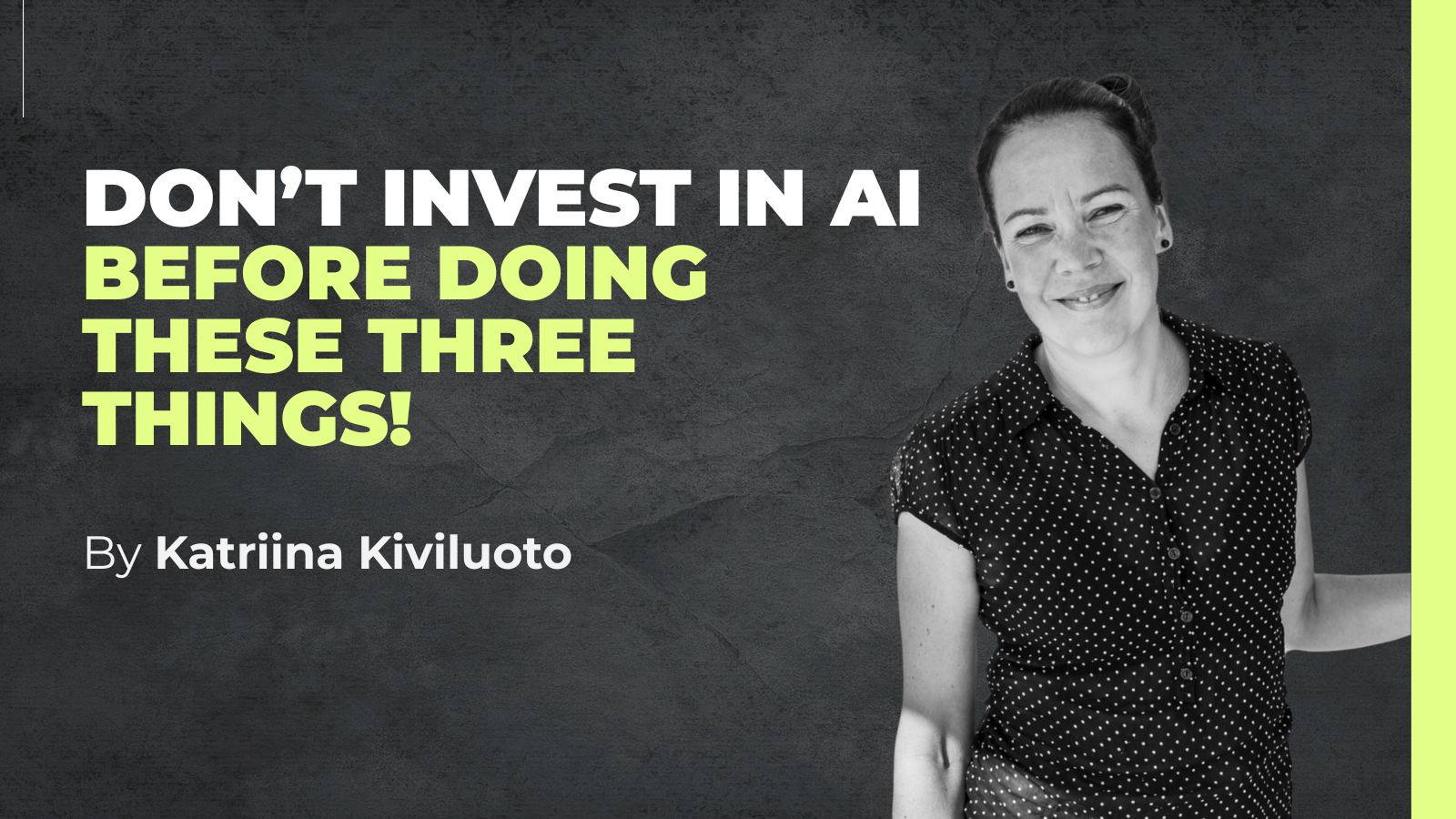Share to gain more social capita
Written by — Katriina Kiviluoto, CEO & Co-founder

Before your AI investment, ensure strong data foundations, align with business value, and prepare your people. Skip these, and AI won’t deliver impact.
Written by — Katriina Kiviluoto, CEO & Co-founder
Share to gain more social capita
This follows my previous article Five proven AI use cases transforming business operations in the Nordics.
May I suggest we pause for a second.
The noise is ear-shattering. The pressure to “do something with GenAI, and fast” is real. Yet I often find myself in conversations with customers who feel unsure: How can we leverage AI in our field? How do we get started the right way? Is it too late? And how do we avoid building another technology for the sake of it?
My advice is don’t start investing in AI before doing these three things first. Skip these, and even the smartest AI solutions won’t deliver real impact.
AI likes to eat data for breakfast, meaning successful AI strategies require strong data foundations. But not just any data; it needs to be consistent, and governed. Too often we see leaders excited about AI, yet they do not even own their data: it’s managed only by the IT department. Because data has not been interesting enough for senior management, it often follows the organizational structure of the company: living in silos, too often being managed in spreadsheets, and being duplicated in shadow systems.
Before you start building your data layer, ask yourself this:
Without a strong data infrastructure, your AI efforts can become expensive prototypes with no production path. And trust me, fixing data in retrospective isn’t that much fun.
Sometimes this step reveals two to three years’ worth of tech debt, and AI often has its own architectural requirements. So what then? Do you have to wait years before doing anything meaningful?
The answer is no. But by identifying your most valuable AI use cases early on, you get guidance on where to start and which technical gaps to fill first.

It’s not about AI, it’s about how it can make us work smarter and businesses more profitable. It’s not meant to be a burden on the company.
Honestly, AI is capable of doing amazing things. But if it doesn’t solve a real problem, it doesn’t matter.
Successful AI projects always start from precise business needs:
Don’t fall into the trap of endless PoCs. If your AI use case doesn’t have a business case to back it, it’s simply not ready for investment. This way, you avoid costly and unnecessary AI investments.
Sometimes people are shy about contacting us for help because they don’t feel they are knowledgeable or experienced in AI. I reassure you; you just need to know your business; we know the AI tools and will make it a reality for you.
AI isn’t something you plug-and-play. It can change how decisions are made, how people work, and how teams collaborate. Organizations that succeed with AI invest just as much in change management as they do in technology.

That means:
Adoption is the biggest barrier to organization-wide impact. If your people don’t trust the AI, they won’t use it.
The best built AI solutions out there are just more intuitive, the end-user actually doesn’t even need to know what happens under the hood. As leaders, we need to be wise in our communication. AI is not mainly taking our jobs but making certain parts more efficient and letting us do more in the present, such as building value for our customers through real human communications and state of the art solutions.
At Recordly, we believe AI should be only one of your business tools. Three things; strong data foundations, business-aligned use cases, and people-first adoption, are the real building blocks of AI maturity.
We’ve seen what works in real-life Nordic organizations: AI solutions that move past the experimentation phase, go live, and drive lasting change. We can think of AI like a skyscraper: the taller you want to build, the deeper and stronger your foundation needs to be. Skip that groundwork, and even the most impressive structure won’t stand the test of time. Please begin with the basics, and that’s all you need to know for starters.
Let’s talk about how you can get it right from the start.
Reach out: katriina.kiviluoto@recordlydata.com | Katriina on LinkedIn
Share to gain more social capita
Written by — Katriina Kiviluoto, CEO & Co-founder